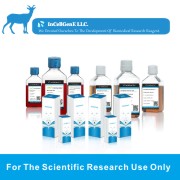

Overview
| Permits and Restrictions | |
|---|---|
| Organism | Homo sapiens, human |
| Tissue | prostate; derived from the metastatic site: lymph node |
| Cell Type | epithelial neuroendocrine |
| Product Format | frozen |
| Morphology | epithelial |
| Culture Properties | floating and attached clusters |
| Biosafety Level |
1
Biosafety classification is based on U.S. Public Health Service Guidelines, it is the responsibility of the customer to ensure that their facilities comply with biosafety regulations for their own country. |
| Disease | stage E, small cell carcinoma |
| Age | 63 years adult |
| Gender | male |
| Ethnicity | Caucasian |
| Storage Conditions | liquid nitrogen vapor phase |
Properties
| Derivation |
Derived from metastatic site, lymph node
|
|---|---|
| Clinical Data |
63 years adult
Caucasian
male
|
| Receptor Expression |
atrial natriuretic peptide (ANP), expressed
|
| HeLa Markers | N |
| Comments |
While NCI-H660 has the appearance and many of the properties of small cell carcinoma, there are also differences. NCI-H660 expresses elevated levels of L-dopa carboxylase and bombesin-like immunoreactivity. The cells express functional atrial natriuretic peptide (ANP) receptors, but ANP addition produces no detectable change in the cells'' growth pattern.
|
Background
| Complete Growth Medium |
HITES medium supplemented with 5% fetal bovine serum
|
|---|---|
| Subculturing |
Add medium as the cell density increases. Shake flask to dislodge attached cells. Single cells are often dead and clusters are viable. Subculture when there are numerous, healthy-appearing clusters present in suspension.
Medium Renewal: Every 2 to 3 days
|
| Cryopreservation |
Freeze medium: Complete growth medium, 40%; fetal bovine serum, 50%; DMSO, 10%.
Storage temperature: liquid nitrogen vapor phase
|
| Culture Conditions |
Atmosphere: air, 95%; carbon dioxide (CO2), 5%
Temperature: 37��C
|


